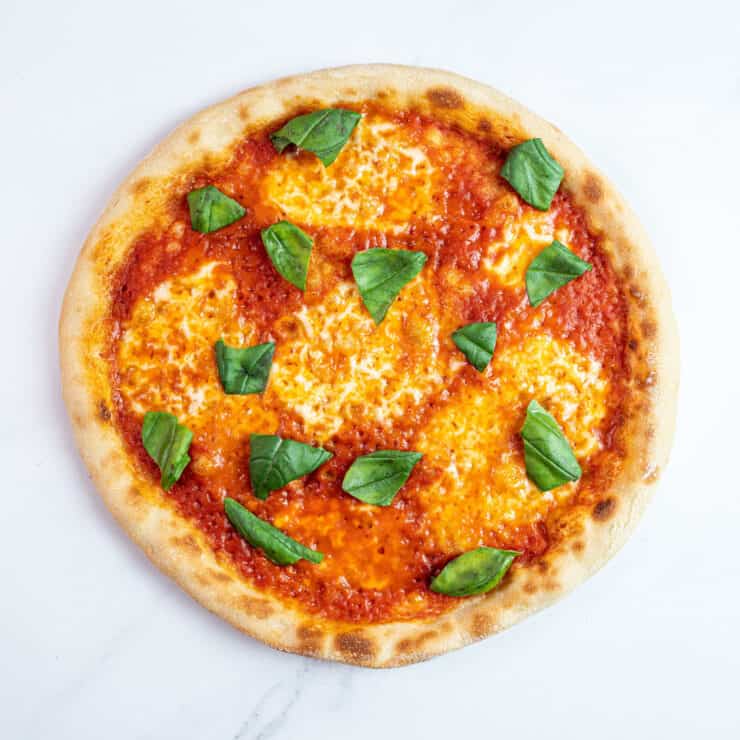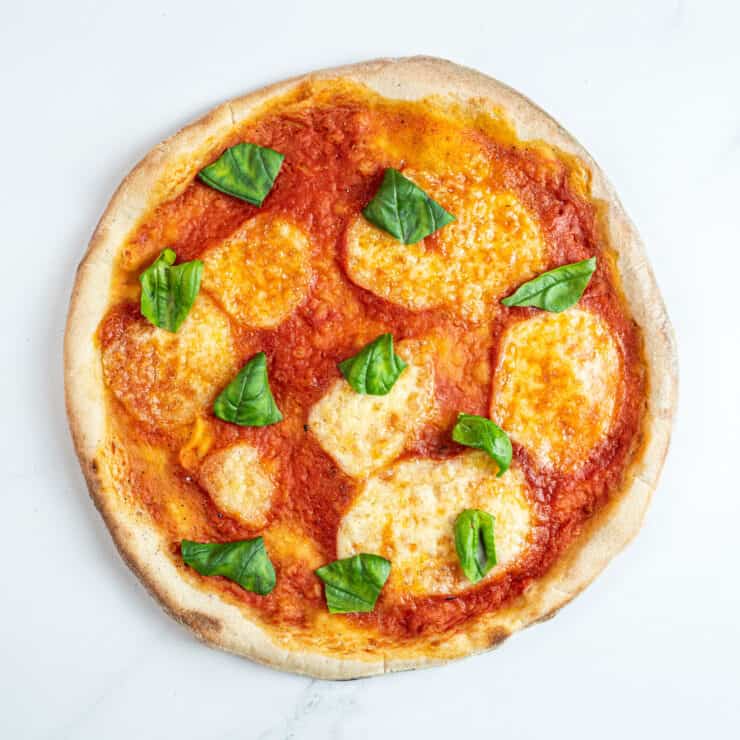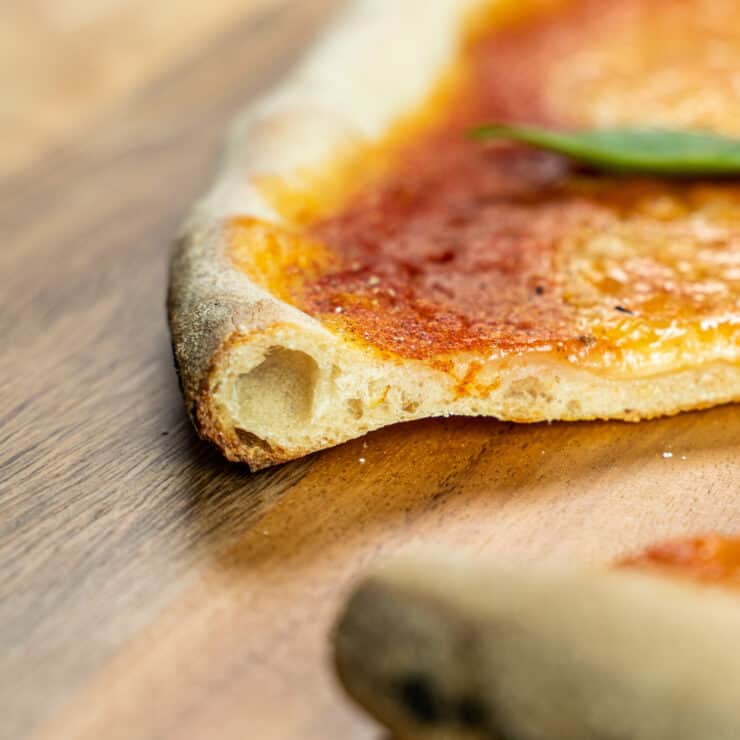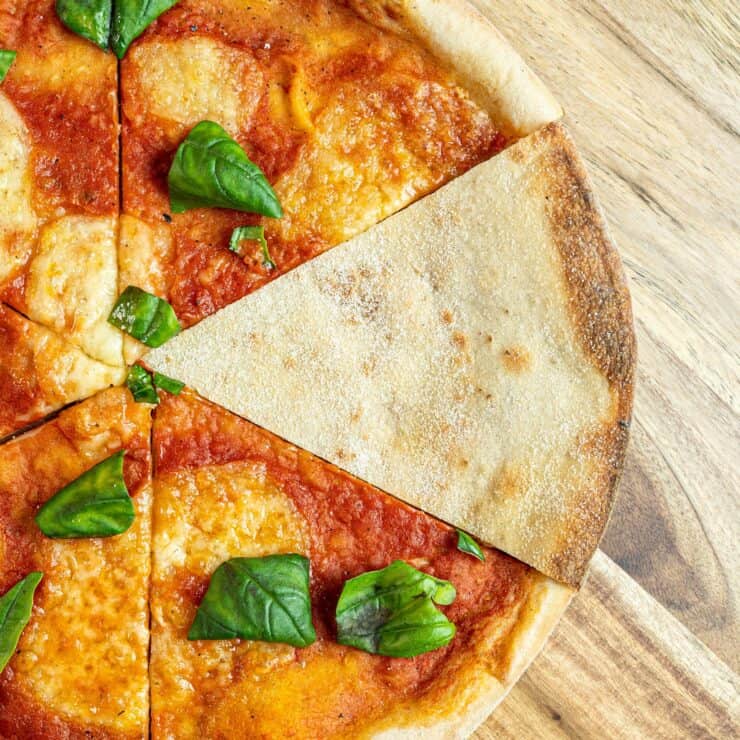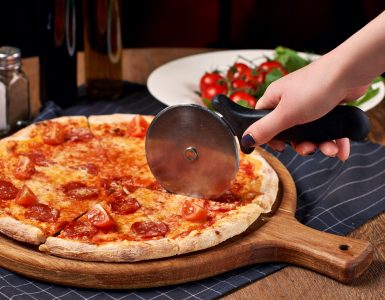The Bottom Line: If you’re looking for a way to make restaurant-quality pizzas at home, look no further than the Breville Smart Oven Pizzaiolo. With just a little practice, you’ll be able to make truly incredible pizzas with a remarkable amount of control over the outcome. While it’s expensive, the Pizzaiolo is worth the price for passionate pizza lovers.
The Breville Smart Oven Pizzaiolo comes at a price, but for the true pizza lover, that may not be an issue. With so many other (and more affordable) options, though, the big question is whether the Pizzaiolo is worth it. And while we would love to give you a simple answer, the truth is that it depends on you.
Even though Cuisine Technology is supported through affiliate income, we’re absolutely committed to complete honesty in our reviews even when that means not making the sale. The honest truth here is that this oven isn’t the right choice for everyone, and many (even most) home pizza cooks can get away with a much more affordable option. Read on to learn whether this pizza oven is the right fit for your situation.
Table of Contents
Quick Summary/Overview
The Breville Smart Oven Pizzaiolo is an indoor oven designed to make incredible pizzas in your home kitchen. With a top temperature of 750° F (400° C), this oven doesn’t get quite as hot as a traditional wood-fired pizza oven—but it comes close, and without all the hassle and expense of building or installing a wood oven in your yard. It also offers fantastic convenience and speed, coming up to temperature within about 20 minutes and cooking thin-crust pizzas in as little as two minutes.
With a focus on the three types of heat transfer (more on this in the FAQ below), the Pizzaiolo does a great job of letting the passionate home pizza-maker achieve truly incredible results. In fact, it can beat the results of many pizza restaurants. This is largely thanks to the individual control over the deck and upper heating elements, and the ability to choose whether the upper heat is spread consistently over the pizza or focused on the crust only.
If you’re just in the mood for a delicious pizza for dinner without all the effort of trying to create the best home pizza ever, the Pizzaiolo still has you covered. It includes automatic settings for various styles, including deep dish/pan pizza and even frozen pizza. In short, the Pizzaiolo makes it easy to create just about any type of pizza you want.
Note: this review features a Pizzaiolo from New Zealand, so the numbers in the pictures are in degrees Celsius. If you buy a Pizzaiolo in the United States, expect degrees Fahrenheit instead.

First Impressions and Ongoing Experience
The Pizzaiolo is immediately captivating on display in the store, partly thanks to Breville’s mastery of incredible food photos for their advertisements. But the Pizzaiolo isn’t all show; it deserves admiration long after the delicious-looking pizza pictures have lured you in. The promise of an indoor oven reaching 750° F (400° C), complete with leopard spotting and beautiful bits of charring, seemed too good to be true.
A year after I first saw the Pizzaiolo on display, I was finally able to get my hands on one of these ovens to review for Cuisine Technology. And let me tell you, it blew me away. This is absolutely the home pizza oven I’ve been waiting for, and it already has a permanent place in my home kitchen.
For some context, I’ve worked as a pizzaiola in high-end gourmet pizza restaurants in the San Francisco Bay Area. I love pizza so much that I built my own wood-fired pizza oven using a custom blend of clays mixed for me by a professor of soil sciences. I’m kind of obsessed with good pizza. And within a few attempts, the pizzas coming out of the Pizzaiolo were as good as any from the gourmet pizza restaurants I’ve worked at—and better than some.
With this oven, I honestly can’t see myself going out to buy pizza unless I’m just feeling lazy. There’s no more sense of compromise between better toppings at home and better crusts from some restaurants, because the Pizzaiolo’s high temperatures allow me to achieve those blistered and leopard-spotted crusts at home.
In short: being smitten at first sight quickly turned into a deep and passionate true love for this oven once I had one of my very own.
Starting It Up
Unpacking the Pizzaiolo is an adventure in its own right. The box is huge, and contains instructions on how to remove the oven without damaging it.
From that point on, things are pretty straightforward. You just follow the (quick and easy) instructions for first-time cleaning, then start up the oven. Especially if you’re using the automatic settings, there’s almost nothing to learn: you just turn it on, let it preheat (this took about 15 minutes for the highest temperature in our tests), and start cooking! Once you switch to manual mode, the controls are still very straightforward, but you might find it takes some practice to dial in exactly the right settings for your perfect results.

The Cooking Process
Most users of the Pizzaiolo will likely opt for the Manual Mode for extra control (see “Other Comments and Considerations” below for more detailed information on this setting). It took me a few tries to find the best settings for my ideal pizza: the deck and the top at the highest temperature settings, and the top control about 70% of the way to “Crust Only”. Depending on your pizza style, though, you may find other options work better for you.
Sliding the pizza into the oven is a little bit of a pain because the Pizzaiolo only comes with a metal peel (ideal for removing pizzas from the oven, but not for putting them in). I didn’t have a small 11” wooden peel on hand, but there was no way I could wait an extra day to play with the new pizza, so I made one attempt on the metal peel (which ended exactly as I expected, with a snagged pizza despite generous semolina). After that, I used an appropriately sized wooden cutting board. In short, if you’re buying this oven, buy an 11” wooden pizza peel at the same time to avoid this hassle.
Unlike most other ovens, there was no need to rotate the pizza in the Pizzaiolo. It consistently cooks evenly and without unexpected hot spots, so as long as the pizza is centered on the stone, it comes out with a consistent cook all the way around. This frees up more time to focus on making the next pizza instead of babysitting the one currently in the oven.
The first time I used the Pizzaiolo, I was so excited about the promise of a truly hot indoor pizza oven that I cranked all the dials all the way up. The pizza (caramelized onion, black garlic, mozzarella, and thyme) was surprisingly good considering my overenthusiasm, though the outer crust was a bit more charred than I intended. The second pizza went a little too far the other way, with the toppings charring before the crust was quite perfect. But then came the Goldilocks moment of discovering the “just right” settings for the style I usually make. You can expect to have a similar trial-and-error phase as you figure out your ideal settings, which is a great excuse to practice by making more and more pizza!
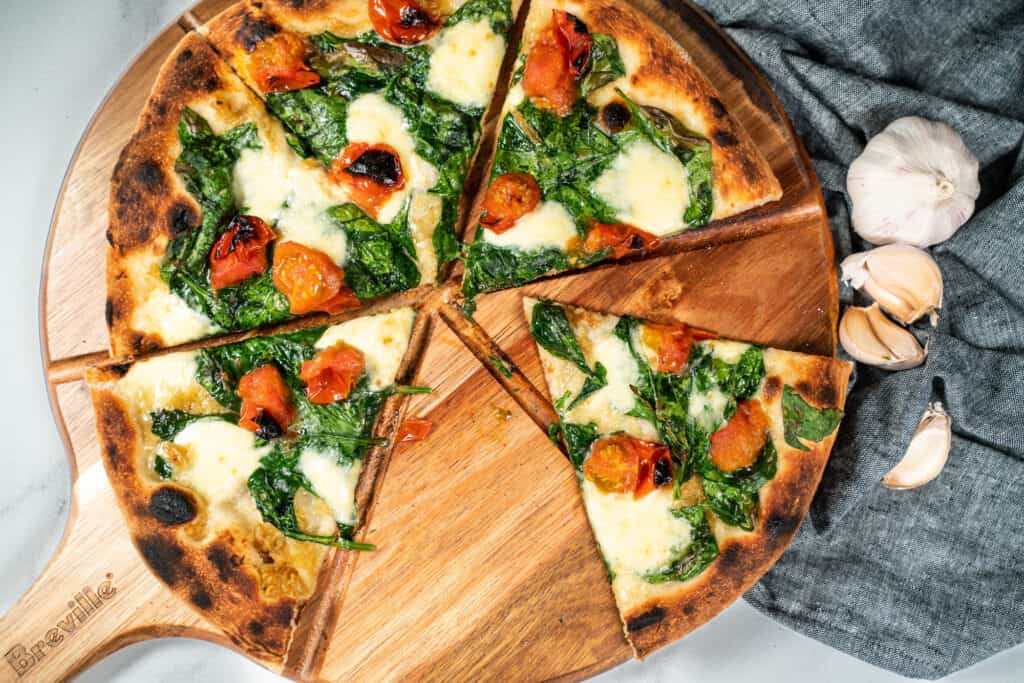
Breville Pizzaiolo Review: Comparison to Other Pizza Ovens
To be able to give you the most accurate review, I’ve compared the Pizzaiolo to three other options: my typical home oven preheated for an hour at its hottest temperature with a pizza stone inside, the Breville Crispy Crust Pizza Maker, and the Ooni Fyra.
For the sake of a straightforward comparison, I made a pretty standard margherita with 00 flour, San Marzano tomatoes, a light amount of buffalo mozzarella, and fresh basil after the pizza was cooked. Take a look at the pictures to see the results from each of these four ovens.
Cooking time:
- The Breville Smart Oven Pizzaiolo: 3.75 minutes
- A standard home oven: 8 minutes
- The Breville Crispy Crust Pizza Maker: 10 minutes
- This Ooni Fyra oven: 13.5 minutes
For this experiment, I used a new-to-me dough recipe that came out slightly denser than my original. As a result, all of these cooking times are a minute or two longer than I normally measure with thin-crust California-style pizzas. Note that the Ooni Fyra theoretically should have been the fastest of all, but after 90 minutes of constant attention and preheating, it hadn’t come anywhere near its target temperature.
In this particular side-by-side experiment, with a slightly thicker/denser crust and raw blended tomato as the sauce, the Breville Pizzaiolo came in at just under four minutes to fully cook the pizza. This is less than half the time that the second-fastest option, the home oven, took. In previous tests of thinner pizzas, the Pizzaiolo typically takes between 90 seconds and 2 minutes. In fact, when I’m using it, I generally set a timer for 90 seconds because it cooks so fast that it’s easy to lose track of time and leave the pizza in too long.
Ease of use:
- The Breville Smart Oven Pizzaiolo: 8/10
- A standard home oven: 9/10
- The Breville Crispy Crust Pizza Maker: 10/10
- The Ooni Fyra oven: 2/10
Aside from the Ooni Fyra, which continually and repeatedly amazes and frustrates me with just how hard it is to actually get going as it’s supposed to, all three options were very easy to use. The Crispy Crust Pizza Maker is the simplest of all, because you just turn it on and then set the dial to whichever type of pizza you want to make. A home oven comes in at 9 out of 10 simply because you’ll need to figure out the right temperature for yourself.
The Breville Pizzaiolo scores an 8 out of 10, which is even more impressive when you consider just how much control it offers you. While mastering the exact right settings for your favorite style of pizza might take some (delicious) practice, the base settings make it easy to get going and create some awesome pizzas from the very beginning.
The Pizzaiolo is a bit like a digital camera in the sense that you can use its “Automatic” mode at first until you’re comfortable with figuring out your own aperture and shutter speed, so to speak. If you’re experimenting and cooking for yourself, you have the option to play around with the manual controls for ultra fine-tuned results—but if you’re having guests over and want to consistently serve great pies, you can rely on the automatic options until you’ve nailed in the manual settings that work for you.
Price:
- The Breville Smart Oven Pizzaiolo: 2/10
- A standard home oven: 10/10
- The Breville Crispy Crust Pizza Maker: 8/10
- The Ooni Fyra oven: 5/10
You presumably already have a home oven, so it wins this category because it’s effectively free. The Crispy Crust Pizza Maker takes second place, coming in at under a fifth of the price of the Pizzaiolo.
Last among the four ovens tested side-by-side for this comparison, the Pizzaiolo’s price tag can definitely give a case of sticker shock. This is especially true if you’re comparing it to countertop pizza ovens like the Crispy Crust Pizza Maker. On the other hand, you can look at the Pizzaiolo as a true alternative to permanent, outdoor, wood-fired pizza ovens, in which case its price is a steal. And while it’s not cheap, it still scores a 2 rather than a 0 or 1 because it gives so much value for the money.
Results:
- The Breville Smart Oven Pizzaiolo: 9/10
- A standard home oven: 6/10
- The Breville Crispy Crust Pizza Maker: 7/10
- The Ooni Fyra oven: 2/10
Among the four ovens tested, the Ooni Fyra was unfortunately the worst, simply because it’s so difficult to preheat fully. After 90 minutes of constant attention and hassling with the pellets and airflow, it was still colder than my preheated home oven. The home oven and Crispy Crust Pizza Maker performed similarly, with the Crispy Crust taking a slight edge because its crust was slightly less chewy throughout and more crispy on the bottom without feeling too overcooked.
Not surprisingly if you’ve read the rest of this review, the Pizzaiolo easily took first place. It’s the newest addition to my personal lineup, and I have the least experience with it, so I expect the results will only continue to get better from here. But even so, the results were noticeably better than any of the other three options. The others turned out really good home pizza, while the Pizzaiolo achieves (and often exceeds) restaurant quality.
The Pizzaiolo got some nice char around the edge of the crust, as well as some beautiful spotting on the bottom. The crust was the perfect combination of soft and pillowy on top, with a thin layer of crispiness on the bottom. It was perfectly cooked throughout without ending up overcooked or tough. Of all the pizza ovens I’ve used, the Pizzaiolo makes the best results other than my actual wood-fired clay pizza oven. For a portable indoor appliance that takes just about 15 minutes to preheat, the Pizzaiolo is genuinely breathtaking.
Other Comments and Considerations
Modes: Manual and Automatic
Most of this review is about how the Pizzaiolo functions using the manual mode. However, its default is an automatic mode that makes things even easier. In this automatic mode, you can select a setting including “Frozen,” “Pan,” “Thick Crust,” “Thin & Crispy,” or “Wood Fired” depending on the pizza style you want to make. You then set a timer, select whether you want the outer crust lighter or darker, and that’s it! When you just want to have a lazy night and toss in a frozen pizza without needing to think, the automatic mode is convenient.
The manual mode option is fantastic. You just stick on a magnetic overlay to show the manual mode settings instead of the automatic settings. It’s surprising that this isn’t the default, since most people who buy and use the Pizzaiolo probably prefer this setting, but it’s easy enough to enter manual mode. Simply hold down the Timer/Deck Temp knob as you turn the Style/Top Deck knob from OFF to 350° F (or 160° C, depending on where you bought the Pizzaiolo). The Manual Mode light will flash then stay on, indicating that you have full control over the settings now.

In manual mode, you have an incredible level of control over the temperature. You can adjust not only the deck temperature, but also the top temperature, and also where the top heat comes from: evenly across the whole pizza, only around the outer crust (for crust charring without overcooking the toppings), or somewhere in between. This level of specific control over not only the temperature but also where the heat comes from is impossible with even the best wood-fired oven.
Size
Be aware that the Pizzaiolo doesn’t fit large pizzas. While it works for other styles, this oven is clearly designed specifically for individually sized thin-crust pizzas (think Neapolitan or California-style). The stone measures 12” (30cm) across, so it’s very difficult to make pizzas over 11”, and impossible to make anything over 12”. If you want to make extra-large pizzas, this oven isn’t the right choice.
Accessories
- Pizza stone (round)
- Pizza peel (metal)
- Pan (carbon steel)
In addition to the pizza stone, the Pizzaiolo comes with a carbon steel pan for deep-dish pizzas. You’ll need to season this before using it. If you love Chicago-style pizza (and who doesn’t?!), you’ll appreciate the extra versatility that this pan offers. I’ve actually also use it to roast vegetables and get a hint of nice charring on their edges, and they’ve turned out perfectly every time.
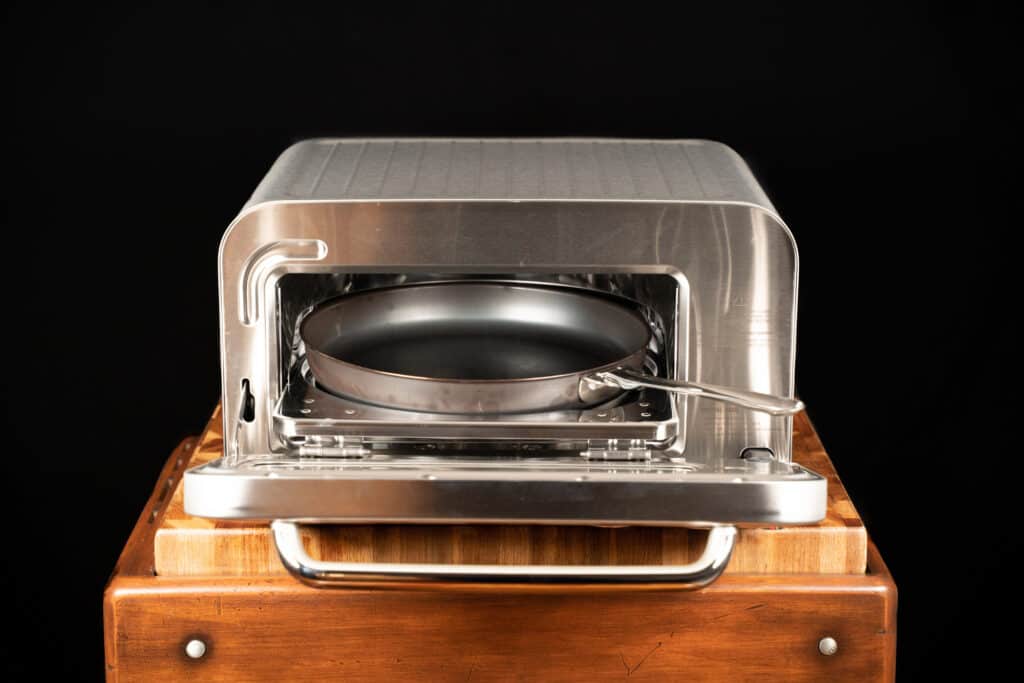
As I’ve mentioned elsewhere, the Pizzaiolo sadly and surprisingly does not come with a wood pizza peel. Plan to source one at the same time you get your oven so you can assemble and slide in pizzas more easily. The oven does include a metal pizza peel, which is perfect for getting your finished pizzas out.
Smoke
Because of its ultra-hot cooking temperatures, the Pizzaiolo tends to emit some smoke and steam. Keep in mind that when you’re cooking at these temperatures, you need to expect some smoke. This may be unfamiliar if you’re used to cooking pizzas in a home oven, so don’t be surprised if you see a bit of smoke coming from the Pizzaiolo (as long as it’s the smoke of charring food, of course, rather than the machine itself). If this concerns you, consider opening a window or turning on your kitchen fan for some ventilation. And, of course, you should always have a fire extinguisher somewhere easily accessible anyway!
If you’re still concerned, note that even Breville’s manual for the device mentions smoke in its Troubleshooting section. Breville’s solution in the manual is to say, “This is normal during cooking due to the extreme high temperatures. To reduce this, try to limit the amount of flour/semolina used on your peel. It is also recommended to use the oven in a well-ventilated area.”

Pros & Cons
Audience – Who Should Buy the Breville Smart Oven Pizzaiolo?
The Pizzaiolo is ideal for pizza connoisseurs who want the leopard spotting, crust charring, and high temperatures of a wood-fired oven indoors without any hassle, inconvenience, or long wait times. The ideal audience for this oven includes:
People who don’t believe pizza is only for the weekends. It used to take me a couple hours to get my outdoor wood-fired oven up to temperature, and even a home oven needs an hour or so to get the pizza stone fully heated. The Pizzaiolo brings the preheating process down to just 15 minutes. This means it’s super practical for weeknight pizzas and casual dinners, because heating up the oven doesn’t need to be a whole event.
Apartment dwellers, those without much outdoor space, or anyone who doesn’t want to depend on the weather for their pizza. Using outdoor-only ovens (such as designated wood-fired pizza ovens or barbecue/grill pizza attachments) is a lot more pleasant in decent weather. These devices also require you to have enough outdoor space. The Pizzaiolo is the perfect alternative for rainy days or apartment-dwellers, since it’s made for indoor use.
True pizza aficionados. Here’s the truth about this oven: if you don’t know what leopard spots on a pizza crust are, this may be too much oven for you. If you’re not pursuing perfection, you can absolutely get away with a much more affordable option. I also own the Breville Crispy Crust Pizza Maker, which is dramatically lower in price and can still cook up a mean pizza. If you’re happy with really good pizzas, save your money. But if you want to take your pizzas to the next level and end up with a better result than most pizza restaurants, I wholeheartedly recommend the Pizzaiolo.
Potentially small pizza business owners. The Breville Smart Oven Pizzaiolo is designed for domestic/home use. However, I’ve heard of several people using it for small pizza businesses, such as pizza stalls at farmers markets or mobile pizza catering. Thanks to its relatively portable size compared to commercial options, its ease of use, and the fantastic restaurant-worthy results, it’s no wonder the Pizzaiolo has found its place in the professional world. Before buying the Pizzaiolo for this purpose, please check your local regulations to ensure it’s compliant with the commercial laws in your area.

Pricing
NOTE: Breville products don’t tend to go on sale often, but you may get lucky. Check the price often to see whether you can get your Pizzaiolo for a steal.
I’ve mentioned it throughout: the Breville Smart Oven Pizzaiolo is not cheap. If you aren’t passionate about pizza and just want a convenient tool for simple family-night pies, a more affordable option is probably a better fit for you.
But if you want truly incredible pizza at home, the Pizzaiolo is worth the price. It gives you an exceptional level of control, and with a little practice, you’ll probably be able to make better pizzas than just about any restaurant around.
Here’s how I look at it. With the Pizzaiolo, I can make pizzas that I like better than any of the restaurants in my city. Equivalent pizzas at those restaurants cost anywhere between $23-$29, depending on toppings. I can make my own pizzas for $3-$9, again depending on toppings (ranging from simple seasonal produce all the way up to imported cheeses and truffled mushroom tapenade). In other words, I’m saving about $20 per pizza. If my spouse and I have pizza once or twice a week, that’s $80 a week in savings—and the oven will have paid for itself in three to six months.
Final Verdict: Is the Breville Pizzaiolo Worth It?
If you fall into its target audience of pizza lovers who want to make restaurant-worthy pizzas at home, the Breville Smart Oven Pizzaiolo is my absolute top pick for the best home pizza oven. I personally own and obsessively use this oven. In fact, since I got it, all my other portable pizza ovens have been banished to the garage. If you’re similarly smitten with pizza, then yes, the Breville Pizzaiolo is worth its hefty price tag.
With that said, this is definitely an investment, and may not be the right choice for you if you just want to make an occasional really good pizza. The Pizzaiolo is for those who want to go past really good to restaurant-worthy.

Alternatives
For an Outdoor Option With a Real Wood-Fired Taste: The Gozney Roccbox
The Gozney Roccbox is capable of making some truly impressive pizzas that look—and taste—like they’ve come from a professional wood-fired pizza oven. Its default cooking method is gas, but we recommend adding on the optional wood-burning attachment so you can get that nice flavor. Even though you’ll pay extra for this attachment, the overall price is still significantly lower than that of the Pizzaiolo (unless you catch an amazing sale).
For a More Budget-Friendly Indoor Option: The Breville Crispy Crust Pizza Maker.
Yes, another Breville! This was my go-to oven before getting my hands on the Pizzaiolo, and I was really impressed with its quality, especially given the price. It’s super easy to use, light and portable, and makes great pizza a breeze. With top temperatures of 572° F (300° C), the Crispy Crust Pizza Maker gets significantly hotter than a standard home oven. It doesn’t achieve the impressively high temperatures of the Pizzaiolo, but at around a fifth of the price, you might be able to forgive it for that shortcoming!
For more details, read our full hands-on review of the Breville Crispy Crust Pizza Maker. Or check it out on Breville’s site or on Amazon.
Breville Smart Oven Pizzaiolo FAQ
Heat Transfer & Traditional Neapolitan Pizzas
While it isn’t a wood-fired brick oven, Breville explains that the Pizzaiolo “replicates the three types of heat generated by a brick oven – conductive, radiant and convective.” This may not immediately sound that exciting, but here’s why it matters. Enzo Coccia—who teaches the art of pizza-making in Naples, Italy—spoke with The Smithsonian Magazine about Neapolitan pizza. He describes the three kinds of heat used in a traditional Neapolitan oven: conduction, radiation, and convection. Sound familiar?
Conduction: this is heat transmitted directly through physical contact. In this case, the heat is transferred from the preheated pizza stone in the Pizzaiolo to the pizza itself.
Convection: this type of heat involves a heated fluid flowing around, carrying heat with it, and transferring that heat. Air is technically a fluid, and in the Pizzaiolo, the convective heat comes from the hot air within the pizza oven transferring its heat into the pizza.
Radiation: this type of heat transfer basically involves something hot sending heat waves toward something cooler. You’ve probably noticed this when you felt heat radiating off a hot building or car as you stood near it, for example. In the Pizzaiolo, the radiant heat comes from the heating coils positioned above the pizza.
If that all reminds you a bit too much of high school physics, here’s the important takeaway: the Breville Pizzaiolo incorporates all three types of heat transfer, which is required for traditional Neapolitan pizzas.
Note: despite the attention to heat transfer, the Pizzaiolo will not technically cook pizzas meeting the guidelines/requirements of the Associazione Verace Pizza Napoletana. This association insists that cooking a true Neapolitan pizza “must be done exclusively in a wood fire oven which has reached the cooking temperature of 485° C, (905F).” As an electric oven with a top temperature of 400° C (750° F), the Pizzaiolo doesn’t meet these requirements. However, Breville’s attention to heat transfer means that this oven will produce pies that come pretty close to replicating the true Neapolitan style in a convenient, accessible way.
What Else Can You Cook in the Breville Pizzaiolo?
In addition to being suited for various types of pizza, the Pizzaiolo works for other foods too. Get creative with ideas such as:
- Roasted vegetables
- Shakshouka with eggs
- Roasted fish
- Fajitas
- Home fries and hash browns
- Flatbreads, focaccia, and similar breads
- Frittatas
Have another idea? Proud of a particular dish you’ve made in your Pizzaiolo? Send us an email to have it added to the list!
Can You Cook Bread in the Breville Pizza Oven?
Yes, you can bake bread in the Pizzaiolo, with one big caveat: it can’t be too tall.
With its exceptional control over temperature and where the heat comes from, this Breville pizza oven is well-suited to baking bread with great results. However, the interior height is just 2.5” (6cm) high measured from the top of the stone to the bottom of the upper heating elements. This makes the Pizzaiolo a perfect choice for things like focaccia, pitas, naan, and other flatbreads. It will not work for loaves of bread, tall buns, or any other breads above about 2” high, however.
How Hot Does the Breville Pizza Oven Get?
The Breville Smart Oven Pizzaiolo reaches 750° F/400° C, with individual controls for the deck temperature and the top temperature. While this doesn’t quite match the top temperatures of a wood-fired pizza oven (which can get to 800° F/425° C and above), it’s far hotter than a standard home oven, which usually tops out around around 550° F or 280° C.
How Much Does the Breville Pizza Oven Weigh?
The Pizzaiolo definitely isn’t light! This pizza oven, with the pizza stone inside, weighs about 33 pounds (15 kilos). While it’s not something you’re likely to want to move around every day, it’s still light enough for one person to manage.
How Do You Cook Frozen Pizza in a Breville Smart Oven Pizzaiolo?
All of us—even the most pizza-obsessed—occasionally just want a lazy evening with a mindless frozen pizza. The Breville Pizzaiolo knows there’s no shame in that, with a mode specifically designed for frozen pizzas.
In Automatic mode, simply set the style to “Frozen.” Once the oven has come up to temperature, cook your frozen pizza for around 12-20 minutes depending on the style and thickness. Set the timer for 20 minutes and check your pizza frequently starting around the 10 minute mark just to be safe!




